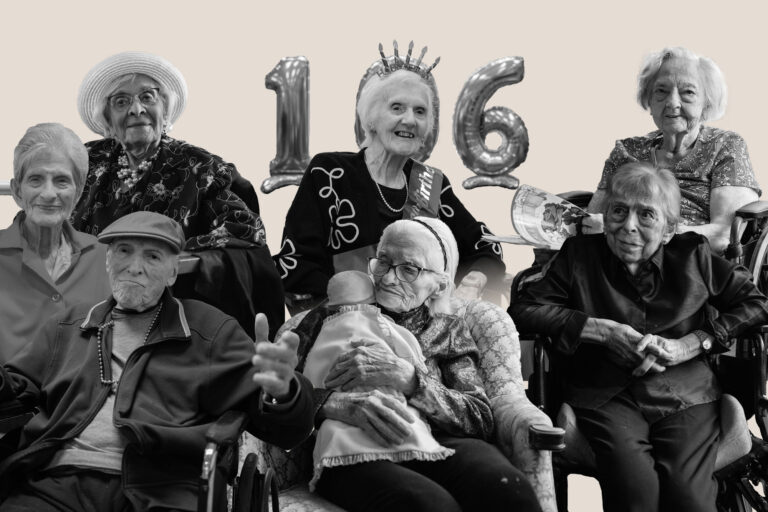
Erin O’Donnell is a freelance health and science writer, parent, and graduate of Northwestern’s Medill School of Journalism. Walks by Lake Michigan make her happy.
While on a cruise with her husband in 2011, Andy Weitzberg suddenly felt compelled to photobomb a young couple getting their picture taken during dinner.
“As a kid, I was always the class clown. I enjoy making people laugh and smile, and I thought that was the perfect opportunity for some fun,” says the 72-year-old Buffalo Grove resident.
Weitzberg asked the couple to send her the photo, which she posted on her newly opened Facebook account. To her delight, she got lots of likes from her friend connections, and soon she became known as Photobombing Grandma on social media.
“My grandkids suggested I post my pictures on Instagram, and they showed me how to use it. I’ve photobombed everywhere from the Chicago Botanic Garden to Wisconsin to Oregon to Italy,” Weitzberg says.
Weitzberg is one of a growing number of seniors on social media. The various platforms — from Instagram to Snapchat, Twitter to YouTube — provide a way for older adults to stay connected, especially during the coronavirus pandemic when it’s harder to get together in person.
“Social media networks are a crucial way for elderly people — and anyone for that matter — to safely stay in touch and social,” says Joseph Rothstein, CEO of Social Media 55, a digital marketing agency.
In addition to posting her photobombs, Weitzberg uses social media platforms to connect with her kids and grandkids. “I post quotes and pictures for them and like seeing their stuff too,” she says.
Before older adults jump on social media, here are a few things to consider.
Choose a channel that makes sense
Rothstein suggests that most older adults start with a Facebook account. Not only is the platform easier to navigate than other platforms, but also “Facebook has the largest pool of monthly active users, so chances are their loved ones, for the most part, will be on Facebook.”
Dan Salganik, managing partner at digital marketing agency VisualFizz in Chicago, agrees. He notes that year over year, the population of users on Facebook has increased. But while it’s popular, the platform has become more complicated to use, with features like Facebook Stories. “The functionality of Facebook has become more complex due to increased service offerings,” Salganik says.
He adds that younger individuals, such as Gen Zers and Millennials, are posting less often on Facebook. Because of this, Salganik suggests connecting with younger family members on communication apps, such as Skype, Zoom, FaceTime, and Google Meet. WhatsApp is good for texting, group messages, and calling, he adds.
Photobombing Grandma Weitzberg originally thought Facebook was easy and Instagram difficult, but over time she learned to use them both for different purposes.
“I use Facebook more now for friends I grew up with and went to school with and old neighbors. I chat and talk more on Facebook. I use Facebook Messenger, too, to call and message my two younger grandkids on their gizmos,” she says. Instagram is good for sharing photos and images.
Learn features one at a time
Once older adults pick a platform, Salganik recommends that younger generations progressively teach older relatives its functions. On Facebook, for example, “Instead of teaching seniors about all of the features Facebook has to offer, only focus on specific functions, such as viewing people’s pages, messaging, liking, signing in and out, adding photos. Make this a progressive process, and don’t overcomplicate,” he says.
Weitzberg takes this approach. “If my kids teach me one thing, I’ll concentrate on that until I master it. Then I go to the next feature. If they start teaching me too much, I’ll tell them they’re out of my ballpark,” she says.
No matter the pace or platform, prioritize user-friendly devices. Rothstein says tablets, such as iPads, tend to be “more conducive to older adults’ learning curves,” plus, it’s easier to enlarge the text. “I think that patience [and giving] your loved one phone support will allow them to kick off getting started,” he adds.
Beware of scams
Talk to older adults about ways to protect themselves online, too.
“I would recommend helping your loved one with their privacy settings in order to further help protect their personal information,” Rothstein says. Familiarize them with potential scams, such as misinformation or phishing emails, and arm them with information on how to combat them.
“Do not click on anything that asks for credit card information, personal information, your home address, Social Security, and more,” Salganik says. “If you receive calls coming from tech companies, they are generally scams, as these companies generally do not call their users.”
When it comes to email scams, Salganik recommends forwarding any message that asks for a password or personal information to more tech-savvy family or friends to get their feedback on whether the email is safe.
“An easy way to check is to see if the email is coming from an [address] that looks legitimate. Some emails might say something like ‘Apple support,’ but when looking at the email address, it will look like Apple.support@shuiesks3321ekse.com,” he says.
While keeping aware of potential dangers online is crucial, remember that by and large, social media offers an engaging way to connect.
Weitzberg remembers all of her photos and the connections she made because of them. However, when the pandemic hit, she had to halt her photobombing.
“With social distancing, I can’t photobomb, because I can’t be in their face, and I don’t want them in my space. In March, I stopped, but after a few weeks, I really missed it,” she says.
To fill the void, she decided to post pictures of herself in silly shirts instead.
“I have a lot of goofy and strange T-shirts, so I started putting them on and posting photos of me wearing them once a week. I’ll go with this until I can photobomb again,” Weitzberg says.
More than connections, Weitzberg says posting photos on social media brings her energy and excitement. “If I’m feeling achy or tired and I go out and do this, I’m energized from it. It’s like plugging in your phone and charging it.”








